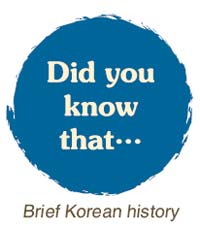Start of Sino-Japanese War
As the 19th century closed, Joseon (1392-1910) increasingly found itself in the center of intrigue and conflict — some of it of its own making. In the summer of 1894, insurrection and unrest ruled the Korean countryside — especially in the southern provinces. The government, unable to put the unrest down by itself, invited Chinese assistance. A large force of Chinese and Korean soldiers was sent into the interior in an effort quell the unrest — they achieved limited success. The introduction of Chinese troops allowed the Japanese — due to a treaty — to bring a large military force of their own and they promptly occupied Seoul and Jemulpo, even going so far as to occupy Gyeongbok Palace on July 23.
It was evident to all that the increasing tension between the Japanese and Chinese would soon lead to war — but few suspected that combat would begin before war had been officially declared.
On July 25, the British-flagged steamship Kowshing was stopped by three Japanese warships while en route to Asan with Chinese soldiers and weapons. The Japanese demanded that the Kowshing follow them back to Japan where the Chinese would be made prisoners of war. Captain Galloway of the Kowshing, refused claiming that war had not been declared. Unbeknownst to him, a small naval engagement (initiated by the Japanese) had taken place a couple of hours earlier between these Japanese men-of-war and two smaller Chinese warships.
For nearly two and a half hours, negotiations were held between the Japanese and Galloway with no success. The Japanese commander, exasperated with the efforts, ordered his men to sink the Kowshing.
A foreign advisor to the Chinese government aboard the ship described it as:
“The torpedo arrived at its aim; it hit the ship amidships, probably exactly at her coal bunkers.” A loud explosion followed and “day became night; coal, splinters (and) water (filled) the air.” As the Kowshing began to sink, many of the Chinese sailors jumped overboard and tried to swim to the nearby islands, while others managed to scramble into a couple of lifeboats. The Chinese who were unable to swim or find space in the lifeboats chose to remain aboard the Kowshing and fired upon the Japanese warship Naniwa with their small guns. Some, allegedly, fired upon their fleeing comrades “probably having the savage idea that if they had to die, their brothers should not live either.”
While the Japanese did make efforts to rescue the foreign members of the Kowshing’s crew, they did nothing to aid the Chinese. In fact, there were allegations that the Japanese fired upon the lifeboats filled with Chinese survivors.
The British consul general in Korea, William Henry Wilkinson, described the attack as murder and the Japanese treatment of the survivors as deplorable. The “helpless Chinese” had been left “to perish of starvation” while clinging to the Kowshing’s mast or fall prey to the sharks swimming around the sunken ship.
He further declared that he felt “admiration for the courage shown by the Chinese troops, who preferred death to the dishonor of being made prisoners by their cowardly assailants.”
On July 28 and 29, a large land battle between Chinese and Japanese troops occurred near Asan. The Japanese completely routed the Chinese forces.
Many died during these early days of a war that had yet to be declared and not all of them were combatants. One such casualty was Joseph (also identified as Jean-Moise) Jozeau, a French missionary, who was murdered near Asan on July 29. Jozeau had been assaulted a year earlier by a group of Koreans — the three principal culprits were condemned to exile — and it was feared that his murder had been a Korean but this proved wrong. It was later discovered that he had been murdered by Chinese soldiers.
It wasn’t until Aug. 1, 1894, that war was officially declared — nearly a week after the sinking of the Kowshing. <The Korea Times/Robert Neff>


























































